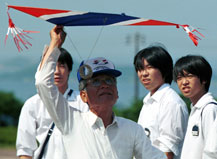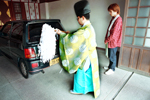Covering
Japan: Nagasaki Journal |
The Students
The Classes
A
Breath of Fresh Air for Kite Fliers
After a Decline in Interest, the Nagasaki Hata Club Goes to Schools
to Demonstrate Ancient Art Form
By Kimberlee Bortfeld
Special to the Mercury News
NAGASAKI, Japan – Eigi Nakamura
may have wrinkles on his face but he’s as animated as a schoolboy.
The 64-year-old retired from his corporate executive job in March and
now spends his days flying kites and teaching the sport to younger Japanese.
 Retired corporate executive Eigi Nakamura demonstrates kite-flying techniques to children in Nagasaki. |
"Speed-o, speed-o," he yells
to a group of boys from Kawarajyo Junior High School. The students are
on a class trip from Osaka, about 350 miles northeast of Nagasaki. The
wind has changed and Nakamura gestures to the students to quickly shorten
their strings.
"When the wind is strong, you let the string out," he says to
them. "But when it is weak, you bring it back." His arms, tanned
by years in the sun, pump back and forth as he demonstrates.
Nakamura has been flying kites, or hata as they are called in Nagasaki,
for 60 years. But he is one of just a few dozen kite masters left in the
city.
Kite making and flying used to be passed down in Nagasaki’s families,
says kite master Akihiro Ogawa, 53. But today, parents are busy with work
and children are so preoccupied with homework, cram schools and video
games that they no longer make time for the sport, he says.
But he and Nakamura hope to change that.
They are members of the Nagasaki Hata Club, a group of kite enthusiasts
dedicated to preserving the sport. All of the club members are over 40.
And most, like Nakamura, are over 60. But while many of them were unable
to interest their own children in the sport, they hope to keep the tradition
alive by teaching school kids – one class at a time.
"My son, who is 30 now, didn’t want to learn hata and that
made me sad," says Nakamura. "But maybe by going out and teaching
people like these students from Osaka, the sport won’t die."
With the support of the Nagasaki board of education, the club conducts
kite making and flying classes in Nagasaki’s elementary schools.
They also offer lessons to visiting school groups from around Japan. For
the students from Osaka, today’s lesson brings many surprises.
"We used to fly kites in elementary school, but it’s not so
popular at our age," says freshman Mariko Ishii, 14. "But today,
I found it really interesting. You usually have to run to fly the kites,
but with these Nagasaki kites you don’t have to run."
With the club members as coaches, students launch the kites as they might
paper airplanes, tossing them forward until they catch wind. Typically
with a flick of the wrist and a tug on the string, the kites, with their
light bamboo frames, take off. They then twirl, spin and dance, slowly
bursting upward into the sky.
"The kites aren’t as easy to control as they seem," says
Akiyo Kurozumi, 14. "But you don’t need a lot of power and
strength to keep them up."
According to Ogawa, the Nagasaki hata evolved from Indonesian kites brought
by Dutch traders in the 1600s. At that time, Japan was closed to the world
except for Dejima island in Nagasaki harbor, which remained open to limited
foreign contact.
The faces of the kites are shaped like diamonds and made from Japanese
mulberry paper or washi. The patterns – made by cutting and pasting
paper – are simple with clean lines. As one teenage girl says, they
are "surprisingly Japanese-looking." The more than 200 traditional
designs, however, retain international origins. Ogawa says that the colors
– red, white and blue – reflect those of the Dutch flag, and
that the patterns resemble ship signals, family crests, Chinese characters,
plants and animals.
But while delicate in appearance, the hata are fierce in the air. Nagasaki
is known for its hata battles, with thousands of kite enthusiasts from
around the world descending on the city each April for the Nagasaki International
Kite Festival.
"If you want to fight the hata, you start by yelling out a warning
to your opponent," says Nakamura. "At some point if the strings
cross and if yours cuts the other one down, you win. And you get his kite."
During fights, a section of the kite’s hemp string is switched with
string coated with powdered glass or bidiro, making it sharp enough to
cut.
While the students from Osaka didn’t get a chance to fight their
hata during the lesson, they say they will take the kites back and have
battles in their schoolyard.
"I’m looking forward to fighting the kites," says Norihiko
Maeda, 14. "It sounds exciting and maybe I will win."
Nakamura, who calls himself a master of hata battles, says he has almost
200 kites at home, many of which he won in such contests.
But the fights are all in fun. For Nakamura and many of the club members,
the benefits of kite flying go beyond ephemeral triumphs.
"On good wind days, the string can get more than a half mile long
so that the kite becomes so small and far away that you can barely see
it," says Nakamura. "Flying hata is also a great way to keep
your body strong. You’re out in nature surrounded by clean air.
It’s good for the soul."
Member Shigeru Okazaki, 56, says kite flying with the students brings
back memories of his own childhood summers. Born during World War II,
he learned the sport from his father and grandfather when he was 6. They
lived on a farm with plenty of open sky.
"When I’m out flying hata, I think back to those times,"
he says. "Kite flying means that summer has arrived."
Club members say they hope that younger Japanese will feel the same affection
for hata as they do, even if for a short while.
"The kids seem to enjoy our lessons very much, but I don’t
know how much they will play with the hata afterward," says Ogawa.
"But I believe that they will never forget it. At least, they will
remember this day."
This story originally appeared in the August 8, 2002 edition of the San Jose Mercury News.

